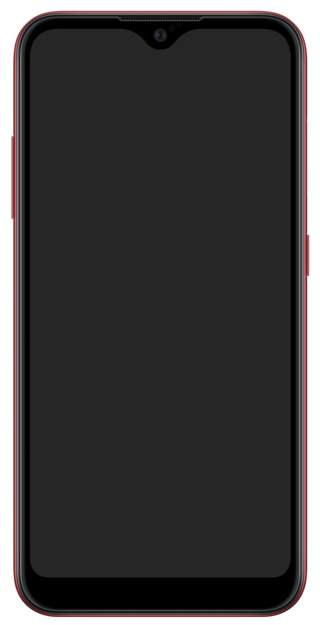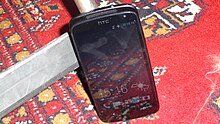The Samsung Infuse 4G was an Android smartphone that was released by Samsung in May 2011. It has a 1.2 GHz Hummingbird processor with 8–16 GB internal Flash memory, a 4.5 inch 480×800 pixel Super AMOLED Plus capacitive touchscreen display, an 8-megapixel camera and a 1.3-megapixel front-facing camera.
HTC Sensation XL is touchscreen-based, slate-sized Android smartphone manufactured by HTC. It was announced on October 6, 2011 by HTC on their Beats Audio event at London and released worldwide on October 26, 2011. The Sensation XL was HTC's second phone that was equipped with Beats Audio sound enhancer technology, after the earlier HTC Sensation XE. Two editions of the HTC Sensation XL were released; the only difference between these two models was that the limited edition was shipped with is Beats Solo's while the normal edition was shipped with the in-ear earphones of those on the Sensation XE.

The Sony Ericsson Xperia ray (ST18i) is an Android smartphone from Sony Ericsson. It was unveiled on 22 June 2011 in Singapore during CommunicAsia 2011. It was announced that the Xperia ray would be released globally in select countries from Q3 2011.

The HTC One S is a premium smartphone designed and manufactured by HTC as part of the HTC One series which has Beats Audio and runs the Android 4.0 "Ice Cream Sandwich" mobile operating system with HTC Sense. Announced by HTC on 26 February 2012, the HTC One S was scheduled for official release on 2 April 2012. The first phones were sold on March 30. In the United States, the One S is carried by T-Mobile and Solavei.

Sony Xperia T is an Android smartphone manufactured by Sony Mobile. Introduced on 29 August 2012, it is Sony Mobile's last device ever introduced to feature the Sony Ericsson liquid energy logo after Sony acquired Ericsson's stake in Sony Ericsson in January 2012. It was released in October 2012.
The Ninetology Black Pearl II (I9400) is a smart mobile phone manufactured by Ninetology with dual SIM capabilities. It is a low-end smartphone, using a dual core (1.0 GHz) processor and runs on the Android Ice Cream Sandwich 4.0 Operating System.
The Dialog i43 is a dual-SIM, slate-format smartphone designed and developed in China by Innos and marketed in Sri Lanka by Dialog Axiata. It operates on the Android platform, with the device initially launched running Android 2.3.5 Gingerbread. The Dialog i35 serves as the predecessor to this phone.
The Samsung Galaxy Pocket Neo is an Android smartphone manufactured by Samsung. It was announced in March 2013 and released in May 2013 as the successor to the Samsung Galaxy Pocket Plus. The handset is still budget-oriented, sporting a larger 3-inch display. Its specifications are similar to that of the Samsung Galaxy Pocket Plus, with only minor upgrades such as the Android 4.1.2 Jelly Bean operating system and the display size. The Samsung Galaxy Pocket Neo, like its predecessors, is still marketed as "Pocket Friendly," because it can be slipped inside pockets easily despite the larger size.
The HTC Desire 601 is an Android smartphone designed and manufactured by HTC. The Desire 601 is a mid-range device carrying design traits from the HTC One and One Mini, utilizing a dual-core processor, 4.5-inch qHD display, and offering LTE support.

The HTC Desire 610 is an Android-based smartphone designed and manufactured by HTC. It is an affordable smartphone part of the Desire range of mid-range handsets, and was aimed at the same market sector with devices such as the Motorola Moto G, Sony Xperia M2 and Nokia Lumia 735. It was announced on 24 February 2014 at Mobile World Congress 2014 in Barcelona, Spain. It was released in China in March 2014, in Europe starting April 2014 and in Australia on 5 August 2014.
The HTC Desire 620 is an Android-based smartphone designed and manufactured by HTC. It is part of the Desire range of mid-range handsets. It was announced on 29 November 2014 in Taiwan. It was announced for the European market on 9 December 2014.
The Samsung Galaxy Ace 4 is a smartphone manufactured by Samsung that runs the Android operating system. Announced in June and released by Samsung in August 2014, the Galaxy Ace 4 is the successor to the Galaxy Ace 3. An LTE model was also announced in 2014.
The HTC Desire 300 is a low-end Android smartphone released by HTC in 2013. The phone was announced on 3 September 2013 in London, England. It was stated that the device would be available in October 2013 in select markets.
The HTC Desire 626 is a mid-range Android smartphone released by HTC in 2015. It comes in single SIM and dual SIM models.
The HTC Desire 616 is a mid-range Android smartphone released by HTC in 2014. It is the first HTC smartphone with an octa-core processor. It was launched on 7 July 2014 in Asian markets. On 11 July 2014, the phone was launched in India for 16900 INR.

The LG L Fino is an Android smartphone/phablet designed and manufactured by LG Electronics. It was released on 10 August 2014.

The Samsung Galaxy A01 is a budget Android smartphone manufactured by Samsung Electronics as part of its A series. The phone was announced in December 2019 and released in January 2020. The phone come in the colors black, blue, and red. The phone features a 5.7-inch 720p touchscreen display, a dual camera setup, and comes with. One UI Core 2.0 over Android 10. A similar device, Galaxy M01, was first released in June 2020, which shares some of the features with the Galaxy A01.

The Samsung Galaxy M31 is an Android smartphone manufactured by Samsung Electronics as part of the Galaxy M series. It was unveiled on 25 February 2020. Its key features include a 6.4 inch Super AMOLED display, a quad-camera setup and a 6000 mAh battery.
Samsung Galaxy J7+ is a mid range Android smartphone produced by Samsung Electronics in 2017. It is also known as Samsung Galaxy C7 (2017) and Samsung Galaxy C8. It was unveiled on 2 September 2017.
Samsung Galaxy F52 5G is a mid-range Android smartphone manufactured by Samsung Electronics as part of the Galaxy F series. It is the first 5G-capable device in the Galaxy F series. It was announced in May 2021 in China and is the first phone in the Galaxy F series to be available in China.








